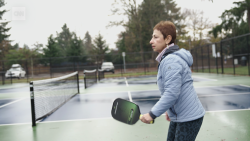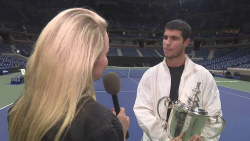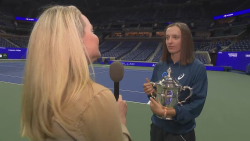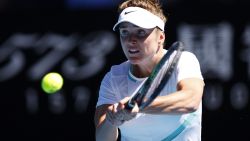After Serena Williams surrendered a 5-1 lead and four match points against Karolina Pliskova in an unbelievable quarterfinal at the Australian Open on Wednesday, the word ‘choke’ did the rounds on social media.
Melbourne’s Herald Sun newspaper subsequently even examined the “worst chokes in tennis.”
In many cases relinquishing such an advantage, especially in a deciding set, could be classified a “choke,” as harsh as that word may be.
READ: What’s next for Federer?
For this author, this was not one of those times. The clear turning point was rather Williams rolling her left ankle on her first match point at 5-1.

Even before then, though, there was drama. Williams was called for a foot fault on her first serve.
Visit cnn.com/sport for more news and videos
That serve, however, wasn’t going to be an ace, despite suggestions to the contrary. The Czech didn’t make a play for the ball because it was an early foot-fault call. The serve was nowhere near the corner and Pliskova would have had a play on her backhand side, no question.
Serve waned after injury
Williams is regarded as having the best serve the women’s game has ever seen and in terms of technique and motion, it could possibly be the best of all time on either tour.
For a start, the ball toss generally never waivers, helping to disguise placement.
Consider that prior to that fateful service game, the 23-time grand slam winner had claimed 12 of the last 15 points on her serve.
After the injury? She didn’t win another point, dropping 10 in succession.
It was, perhaps, an unprecedented occurrence. That just doesn’t happen to Serena.

The left foot is the one Williams not only pushes off on on the serve but the first one she lands on after striking it.
Mind you, no matter which foot or any part of the body – be it a knee, leg, back, shoulder, the stomach – the serve will suffer if in physical distress.
Her first-serve percentage on those 10 points plummeted to 40% and Williams hit three double faults.
How many double faults did she hit prior to the injury? One in two-and-a-half plus sets.
While double faults can be a clear sign of a player so-called getting tight, not here.
Great closer
Williams is one of the game’s best ever closers, too.
If the assumption that a “choke” refers only to a player conceding a hefty lead, especially in trying to get over the finish line, there was no history of this for Williams on her comeback that began last year after giving birth to daughter Alexis Olympia.
She lost both the Wimbledon and US Open finals in straight sets.
That is an issue in itself. Yes, nerves or tension can also lead to those types of results but in Williams’ case it likely had more to do with very little match practice after giving birth.
Williams certainly didn’t have any issues closing out her fourth-round match against, on paper, a more considerable foe than Pliskova in world No. 1 Simona Halep on Monday. With it a closer third set at 5-4, that should have been the tougher one for Williams.
The injury was sure to have rattled Williams, leading her to think more about that than trying to see off Pliskova. The physical limitations brought on by the injury intertwined with the loss of focus turned into one big snowball in now steamy Melbourne.
The bottom line is that Williams has gone four straight grand slams without winning a title, which last happened in 2011-2012.
Her circumstances are different to her fellow 37-year-old, Roger Federer, who claimed the last of his 20 majors 12 months ago Down Under.
While Federer hasn’t achieved a semifinal at a major, either, since Melbourne 2018, Williams landed in a pair of grand slam finals.

Not that Federer should be counted out. That would be foolish given his pedigree and his resurgence following a knee injury in 2016.
If, however, one had to prognosticate on which one of the all-time greats will pick up more majors, Williams looks to have the edge.
Motivation still there
Alarm bells go off when champions such as Williams start to lose to much lower-ranked players or struggle, and that wasn’t the case for the American in her first three rounds at the Australian Open.
She said the fire was “absolutely” still there after losing to Pliskova. This is someone who isn’t going to leave the game with a whimper.
Her defeat at Melbourne Park on Wednesday should be marked with a huge asterisk.
She’ll be back and grand slam number 24 will follow at some point soon, be it on her favorite surface of clay at Roland Garros or more likely on the grass at Wimbledon.




















